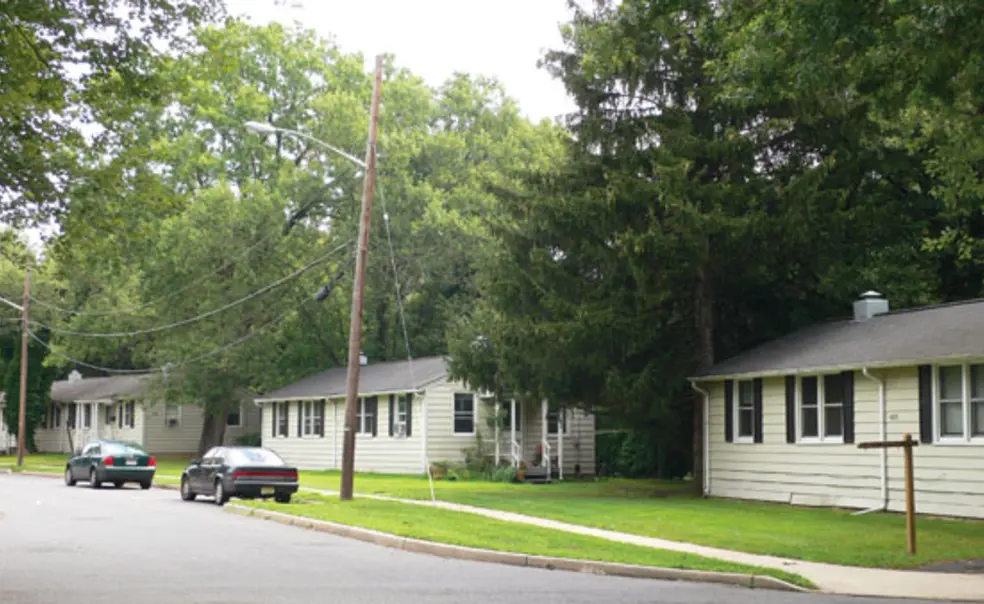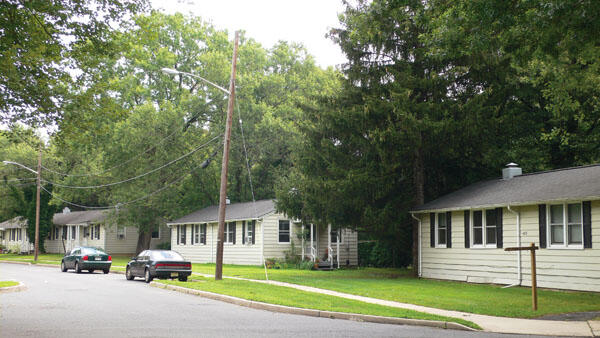The end is in sight for Butler apartments
When the Butler apartments were built on the old polo field in 1946–47 to quickly provide student housing for newly returned married veterans, the intent was to provide additional housing in short order and to demolish the barracks-style units within five years.
Six decades later the 304 apartments of the Butler tract still house about 400 graduate students — but the clock is ticking. By June 2012 the Butler apartments will be vacated and subsequently torn down as part of a plan, estimated to cost more than $100 million, to upgrade housing that the University provides for graduate students, faculty, and staff.
“This is a major step toward continuing to fulfill our commitment to house a major portion of our graduate students in a way that helps build community and will keep as many as possible close to campus,” said William Russel, dean of the Graduate School.
The University proposes to move grad students into apartments that are currently occupied by faculty and staff. In turn, new apartments, town houses, and single-family homes for faculty and staff are planned for the 33-acre Butler tract, and new faculty/staff apartments are planned just west of Dean Mathey Court at Harrison Street and Faculty Road.
Here are the major elements of the plan, as outlined in a letter to grad students by Director of Housing Andrew Kane:
• In 2010–11 the 96-unit Hibben apartment complex, which overlooks Lake Carnegie and has about 45 percent grad students and 55 percent faculty and staff, will be closed for major renovations. The building will reopen in the fall of 2011 solely for grad students. The new rental units adjacent to Dean Mathey Court also are expected to be constructed in this time period.
• In 2011–12 the 96-unit Magie apartment building, adjacent to Hibben and with a similar percentage of grad students and faculty/staff, will be shut down for renovations. It will reopen in the fall of 2012.
• The 154-unit Stanworth apartments, located several blocks north of Nassau Street off Bayard Lane, gradually will change from faculty/staff to grad student housing between 2011 and 2014.
• The Butler apartments are to be demolished in 2012 and replaced by
a variety of housing for faculty and staff. Tentative plans call for about 40 single-family homes, 70 town houses, and 100 apartments.
In response to the plan, some grad students distributed a flier with the message: “Save Butler! They’re coming to take our homes! 60 years of beautiful tradition — gone!” The Graduate Student Government Executive Committee said the current amount of University housing is “not sufficient,” given the challenges of finding affordable off-campus apartments.
In addition, graduate students have called for their own social space on campus as housing becomes more dispersed. Russel said that concern was “not without merit,” but that it is unclear how the reopening of Campus Club this fall may help address that need.
The University is committed to providing housing for about 70 percent of all graduate students who do not have Dissertation Completion Enrollment (DCE) status, Russel said, although the current percentage — boosted by grad students who live in the new four-year undergraduate colleges — is closer to 78 percent, a record number. University housing is guaranteed to every first-year grad student who requests it. In subsequent years grad students participate in a room-draw system, and demand exceeds the supply.













4 Responses
“Petey” Funk s’50 *52
9 Years AgoLife in ‘The Project’
You have had several articles and letters related to the Butler Tract (Notebook, April 2; letters, June 11); however, I have not seen one from any of the original occupants, so you might be interested in our experience.
My husband, Harley Funk ’50 *52, and I moved into the Butler housing tract, aka “The Project” and more commonly referred to as “The Rabbit Patch” for obvious reasons, in February 1947 during a snowstorm. We had been living in one room in an off-campus University residence where, along with other couples, we had to wait our turn for a space in the communal refrigerator. We were elated with the move to The Project and managed the first couple of years with no car, riding back and forth to the campus on bicycles. While Harley pursued his degree in architecture, I worked for five years as departmental secretary of the philosophy department before giving birth to our first child.
In the beginning, The Project was open not only to graduate students and young faculty, but to undergraduates as well. Harley and Donald Riddle ’49 *56 (who went on to become chancellor of the University of Illinois in Chicago) were the only married freshmen. Our concern that the predicted five-year life span of The Project would find us homeless if Harley pursued graduate work turned out to be a needless worry!
We felt we were living in luxury, despite the fact that our heat came from a space heater fed by kerosene carried in from the backyard. And we solved the problem of an overflowing pan under the icebox by drilling a hole in the floor. Many of our bachelor friends on campus loved to visit us for a home-cooked meal, a little female company, and perhaps a game of bridge.
Our neighbors were changing all the time, but at one time they included the philosophers John Rawls ’43 *50 and Walter Kaufmann, among others who went on to become famous. And I was at my office (Woodrow Wilson’s old office in 1879 Hall) the day Bertrand Russell received the Nobel Prize, when the phone rang off the hook with reporters trying to contact him before his lecture that evening. Harley and I also attended a cocktail party given by department chairman Robert Scoon for T.S. Eliot when he had just received the Pulitzer Prize, another memorable occasion.
Those six years in Princeton provided us with a lifetime of wonderful memories, as well as continuing friendships with former neighbors, students, and faculty.
Leslie McShane Roach k’46
5 Years AgoBruce ’46 and Mary Crane
My mother, Mary Tiernan Crane McShane, and her husband Bruce Crane ’46 lived on Lake Carnegie in the married student housing when they were first married in 1946 and returned to Princeton so that Bruce could finish his degree. Bruce Crane died in 1950 in a car crash and my mother married another Princeton graduate Gordon McShane ’45 three years later. My brother Bruce and I were adopted and our name changed on our birth certificates from Crane to McShane. I was born in Princeton, Nov. 14, 1947, while Mary and Bruce Crane were living in the Lake Carnegie housing. I am in the process of writing a family memoir and have nothing but unsubstantiated stories of that period of my parents’ life. I was delighted to find this article from the PAW written by Petey Funk and wanted to see if she or anyone at Princeton has any more information about my father Bruce Crane or can direct me to further information on that housing.
Bill Neidig ’70
9 Years AgoA tree grows in Butler
[node:field-image-collection:0:render]
I read about the scheduled demolition of the Butler graduate student apartments (Notebook, April 2) and wanted to relate a family story. The photograph below shows my wife, Christy, and daughter, Stephanie, in front of a tree at 221C Halsey St. The tree was planted on September 27, 1947, by Lorenz A.E. Eitner *52. At the time Lorenz was a graduate student at Princeton. The occasion was the birth of his daughter, who would become my wife. The tree was a sapling that Lorenz took from the shore of Lake Carnegie while on a walk and transported in his coat pocket.
Lorenz’s time at Princeton was interrupted by World War II. He served as an officer in the U.S. Army’s Office of Strategic Services, doing intelligence work, liberating his former hometown of Salzburg, Austria, and later as a Nuremburg war-crimes investigator. After the war Lorenz returned to Princeton with his wife, Trudi, to complete his degree in art history. After Princeton, Lorenz taught at the University of Minnesota. In 1963 he was appointed chairman of the Stanford University Department of Art and director of the Stanford University Art Museum, positions he continued to hold until retirement in 1989. Lorenz is truly one of the great minds in the field of art history. My life has been greatly enriched through my association with Lorenz and Trudi.
Returning to the photograph: I took it in February of 2003, while we were on a tour of the campus with our daughter. The picture was included with an essay our daughter wrote in her Princeton application. Stephanie had one wish — to be able to spend four years with her mother’s tree. Stephanie graduates in June as a proud member of the Class of 2008.
Robert L. Christensen ’50
9 Years AgoGrateful for Butler
The recent article on the forthcoming demolition of the Butler housing tract (aka The Project) brought back warm memories.
Recently out of the Navy and having been accepted as a graduate student in the physics department, I and my wife, Barbara, were searching for a place to live in August 1953. Time was of the essence, as she was to produce our first child (Robert Jr. ’75) in November.
We considered ourselves very fortunate to be able to rent one of the Butler apartments in such a friendly, convenient (not to mention economical) neighborhood, among other dedicated graduate students and junior faculty. Living there was a marvelous experience, augmenting (sometimes relieving) the excitement of graduate studies and thesis requirements.
With the arrival of our second son, William, in June 1956, we were a happy family there until I received my Ph.D. in 1957. We remain grateful for the opportunities Butler provided us and hope Princeton’s plans for a modernized housing facility will provide tomorrow’s students and faculty the advantages we enjoyed.